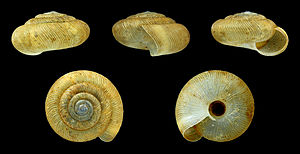Slices
| Slices | ||||||||||||
|---|---|---|---|---|---|---|---|---|---|---|---|---|

Disc snail ( Pleurodiscus balmei ) (Potiez & Michaud, 1838) |
||||||||||||
| Systematics | ||||||||||||
|
||||||||||||
| Scientific name of the family | ||||||||||||
| Pleurodiscidae | ||||||||||||
| Wenz , 1923 | ||||||||||||
| Scientific name of the genus | ||||||||||||
| Pleurodiscus | ||||||||||||
| Wenz , 1919 |
The genus Pleurodiscus is the only genus of pleurodiscus (Pleurodiscidae), a family from the subordination of the terrestrial gastropods (Stylommatophora). The four species of the genus and family live very hidden in caves, under stones and in the earth.
features
The shells are disc-shaped (hence the name disc snails) with a wide navel. The diameter is up to about 10 mm; up to 5½ regularly increasing turns are formed. The surface is ornamented with clear, sharp ribs that run parallel to the edge of the mouth. The color of the case is light brown to yellowish brown. The edge of the mouth is pointed, simple, not thickened or turned over. The soft body is gray-brown. The antennae are relatively long and the tips of the antennae are bent backwards. The penis has no appendages in the male part of the reproductive system. The spermatic duct (vas deferens) attaches to the slightly swollen end of the epiphallus. The transition from the penis to the epiphallus is marked by the attachment of a thin penile retractor muscle. The penis is more or less cylindrical and has a number of thin but clearly defined folds on the inside. In the female part of the genital system, the free fallopian tube is longer than the vagina. The uterus can contain one or two embryos.
Geographical distribution, occurrence and way of life
The distribution of the genus (and the family) is now essentially limited to the central and eastern Mediterranean region (Sardinia, Sicily, Malta, northern Algeria, northern Tunisia, western Turkey and offshore islands, Syria, Lebanon, Israel). Small populations of the Pleurodiscus type species are found in the greenhouses of some botanical gardens in the UK . In the meantime this species has at least also been introduced to Australia. In the Neogene the diversity and the range of the genus was even greater.
The few species live in crevices, caves and under stones in the wasteland. Like all land snails, the animals are hermaphrodites that can fertilize each other or themselves. The development takes place via yolk-rich eggs that are "hatched" in the mantle cavity ( ovoviviparous ). The hatchlings leave the mantle cavity as finished little animals.
Systematics
The family of slugs (Pleurodiscidae) is one of 13 families of the superfamily Pupilloidea . It contains only one genus with four species. Other fossil species have been described.
- Family slugs (Pleurodiscidae Wenz, 1923)
- Genus Pleurodiscus Wenz, 1919
- Disc snail ( Pleurodiscus balmei (Potiez & Michaud, 1838))
- Pleurodiscus asteriscus Bank & Menkhorst, 1991
- Pleurodiscus cyprius (Kobelt 1896)
- Pleurodiscus sudensis (Pfeiffer 1846)
- Genus Pleurodiscus Wenz, 1919
swell
Individual evidence
- ↑ M. Shea: First pleurodiscid snail in Australia. Australian Shell News, 6 (40), 1982. ISSN 0310-1304
- ↑ Species according to AnimalBase AnimalBase - genus Pleurodiscus
literature
- Rosina Fechter and Gerhard Falkner: molluscs. 287 pp., Mosaik-Verlag, Munich 1990 (Steinbach's Nature Guide 10) ISBN 3-570-03414-3
- Michael P. Kerney, RAD Cameron & Jürgen H. Jungbluth: The land snails of Northern and Central Europe. 384 pp., Paul Parey, Hamburg & Berlin 1983 ISBN 3-490-17918-8
- Anatolij A. Schileyko: Treatise on Recent terrestrial pulmonate molluscs, Part 1. Achatinellidae, Amastridae, Orculidae, Strobilopsidae, Spelaeodiscidae, Valloniidae, Cochlicopidae, Pupillidae, Chondrinidae, Pyramidulidae. Ruthenica, Supplement 2 (1): 1–127, Moscow 1998 ISSN 0136-0027